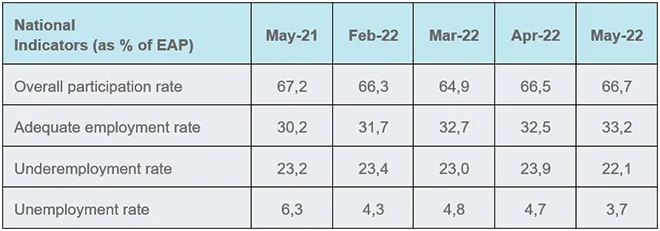
While the world is still reeling from the brutal impact of the COVID-19 pandemic, the Russia–Ukraine conflict and the devastating blow to economies, supply chains, and fuel prices, a small Latin American country, Ecuador, is also facing massive country-wide protests that have brought the nation to a near standstill. The protests were started by the Confederation of Indigenous Nationalities of Ecuador, also called CONAIE, credited with
unseating three presidents between 1997 and 2005, on 13 June 2022. Almost three weeks since, the protests are still raging widely across the country.
The principal reason behind the start of the protests was the spike in
fuel and food prices in the country and their consequent shortages. The increasing prices were the final straw for the citizens living in a country that had faced worsening economic woes. Ecuador is beset with poverty and rampant inequality, however, the pandemic deepened these structural issues in the country. More than
32 percent of the population in the country lives in poverty, earning less than US$3 per day. Unemployment rocketed during the pandemic as well with the recovery remaining slow, as only around
33.2 percent of Ecuadoreans possess formal employment.
22.1 percent remain underemployed in the country, as per the May 2022 reports from the statistics institute of Ecuador.
 Source: The Statistics Institute of Ecuador
Source: The Statistics Institute of Ecuador
CONAIE called for an
indefinite strike to tackle these issues, with demands that the government cut fuel prices, put price controls on agricultural products, a moratorium on bank debts and increase the educational budget, among others. The Ecuadorean government, under President Guillermo Lasso, had taken certain austerity measures including tax hikes and slashing fuel subsidies which were part of a US
$6.5 billion deal with the International Monetary Fund (IMF), which proved to worsen the state of an already weakened economy. A slight paradox here is that the global increase in oil prices has benefited Ecuador as fuel,
specifically petroleum or crude oil, is one of the country’s chief exports. However, the consequent benefits of this increased price have
not trickled down to those who need it the most, further fanning the discontent amongst the people.
The demonstrations are the biggest the country has seen in three years. While most have remained largely peaceful, some of them have
regrettably devolved into looting with some protestors even puncturing the wheels of public buses and shooting at soldiers and police officers. So far, the protests have been linked to
eight deaths, one of them a soldier who was killed in an attack on a fuel convoy. The protests have also caused further weakening of the economy with the demonstrations and the blockades being held responsible
for over US $100 million worth of losses in produce and export activities and US
$2 million losses reported in the dairy industry, which has seen an approximate 4,000 litres of milk wasted daily. The situation had deteriorated to an extent that the government had to declare a
state of emergency in six provinces in Ecuador, including Quito, for a brief period. The emergency has now been lifted. However, the country’s energy ministry on 26 June 2022, warned the protestors that the
oil production in Ecuador has reached a ‘critical’ level and could be halted entirely within 48 hours if protests and roadblocks continue. The tourism industry has also seen losses amounting to
at least US $50 million, with a rise in cancellations due to the prevailing situation in the country.
The situation had deteriorated to an extent that the government had to declare a state of emergency in six provinces in Ecuador, including Quito, for a brief period.
The government, in its response, has tried to repress the protests, blaming the protestors for creating havoc and causing damage to public property and government officials. Since 14 June,
the Ecuador Alliance for Human Rights has recorded 79 arrests, 55 injuries, and 39 episodes of human rights violations like excessive use of force, arbitrary detentions of demonstrators, attacks on journalists and intimidation of civil society organisations
. Amnesty International has emphasised that the government must address the structural causes of the protests, including the economic crisis and the impact of the policies on the rights of groups most affected by the pandemic, such as the Indigenous People and those living in poverty. Blaming the government’s inability to handle the protests, the Opposition in the country sought to remove Lasso, over the
‘serious political crisis and internal commotion’ caused by the protests. This led to an impeachment vote against Lasso, which he survived narrowly, with the motion receiving
80 of the 92 votes required.
Lasso had also
announced a cut in petrol prices on 26 June 2022, by 10 cents per gallon. However, this fell short of the demand put forth by CONAIE to cut the price from US $2.55 to US $2.10 a gallon and diesel from US $1.90 to US1.50. Therefore, the Confederation rejected the price cut, claiming it to be insufficient. Yet, it agreed to meet with government officials to
discuss possible solutions that could lead to the end of the strike. However, post the impeachment vote last week, Lasso announced his decision to end talks with CONAIE, stating that the indigenous leader, Lenidas Iza, is only
defending his own political interests and not those of his base.
Evaluating the current protests, analysts claim that the widespread nature of the protests is an indication that the country could face an extended period of unrest and escalation.
Ecuador last saw such massive demonstrations in 2019, when tens of thousands of citizens marched on Quito, demanding that the government reinstate a long-running subsidy on oil prices that the government had claimed cost US $1.4 billion a year. The President at the time, Lenín Moreno, reinstated the subsidy and later shifted to a pricing system that fluctuates with the global markets. However, as fuel prices started rising in 2021, Lasso
ordered that the prices be fixed, although Indigenous and other groups in Ecuador claimed that the set price was still too high. Evaluating the current protests, analysts claim that the widespread nature of the protests is an indication that the country could face an extended period of unrest and escalation.
Amidst the protests and the crisis Ecuador faces, the United States (US) is getting increasingly anxious as they fear the pro-US government of Lasso may be at risk of falling. Experts in the US claim that former leftist President Rafael Correa, who left office in 2017, is a stringent opponent of the present government and remains highly influential in the country and also seeks to return to power at any price. An added contention is that
the radicalisation of CONAIE is one of his strategies to take back power. This potential change in power would majorly hurt US interests which are facing an increasing wave of pro-left governments in its backyard, Latin America, with the latest country electing a left President being Colombia. The Government of Ecuador must attempt to negotiate with the protestors and come to a compromise as soon as possible to minimise the damage not just to the economy of Ecuador, but also to protect its own political interests.
The views expressed above belong to the author(s). ORF research and analyses now available on Telegram! Click here to access our curated content — blogs, longforms and interviews.



 While the world is still reeling from the brutal impact of the COVID-19 pandemic, the Russia–Ukraine conflict and the devastating blow to economies, supply chains, and fuel prices, a small Latin American country, Ecuador, is also facing massive country-wide protests that have brought the nation to a near standstill. The protests were started by the Confederation of Indigenous Nationalities of Ecuador, also called CONAIE, credited with
While the world is still reeling from the brutal impact of the COVID-19 pandemic, the Russia–Ukraine conflict and the devastating blow to economies, supply chains, and fuel prices, a small Latin American country, Ecuador, is also facing massive country-wide protests that have brought the nation to a near standstill. The protests were started by the Confederation of Indigenous Nationalities of Ecuador, also called CONAIE, credited with 
 PREV
PREV


